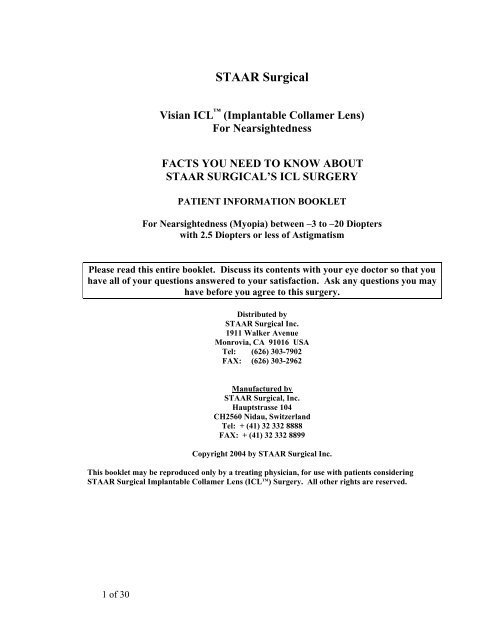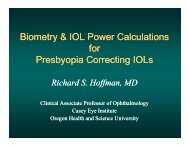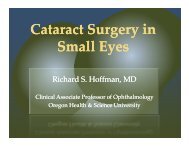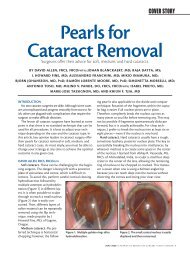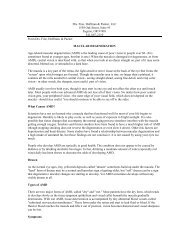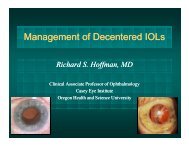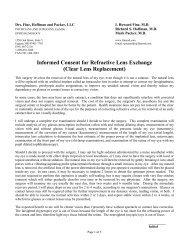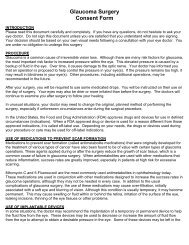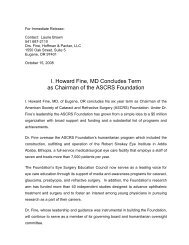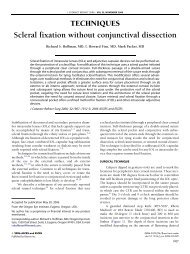ICL Patient Information Booklet
ICL Patient Information Booklet
ICL Patient Information Booklet
You also want an ePaper? Increase the reach of your titles
YUMPU automatically turns print PDFs into web optimized ePapers that Google loves.
1 of 30<br />
STAAR Surgical<br />
Visian <strong>ICL</strong> (Implantable Collamer Lens)<br />
For Nearsightedness<br />
FACTS YOU NEED TO KNOW ABOUT<br />
STAAR SURGICAL’S <strong>ICL</strong> SURGERY<br />
PATIENT INFORMATION BOOKLET<br />
For Nearsightedness (Myopia) between –3 to –20 Diopters<br />
with 2.5 Diopters or less of Astigmatism<br />
Please read this entire booklet. Discuss its contents with your eye doctor so that you<br />
have all of your questions answered to your satisfaction. Ask any questions you may<br />
have before you agree to this surgery.<br />
Distributed by<br />
STAAR Surgical Inc.<br />
1911 Walker Avenue<br />
Monrovia, CA 91016 USA<br />
Tel: (626) 303-7902<br />
FAX: (626) 303-2962<br />
Manufactured by<br />
STAAR Surgical, Inc.<br />
Hauptstrasse 104<br />
CH2560 Nidau, Switzerland<br />
Tel: + (41) 32 332 8888<br />
FAX: + (41) 32 332 8899<br />
Copyright 2004 by STAAR Surgical Inc.<br />
This booklet may be reproduced only by a treating physician, for use with patients considering<br />
STAAR Surgical Implantable Collamer Lens (<strong>ICL</strong> TM ) Surgery. All other rights are reserved.
2 of 30<br />
This page left blank intentionally.
3 of 30<br />
TABLE OF CONTENTS<br />
1. Introduction.............................................................................................................. 5<br />
2. How Does Implantable Collamer Lens Correct Nearsightedness? ..................... 5<br />
3. What Are The Benefits of <strong>ICL</strong> For Nearsightedness?.......................................... 8<br />
4. What Are The Risks of <strong>ICL</strong> For Nearsightedness? ............................................ 11<br />
5. Alternative Treatments: ........................................................................................ 12<br />
6. Contraindications................................................................................................... 13<br />
7. Warnings................................................................................................................. 13<br />
8. Precautions ............................................................................................................. 14<br />
9 Are You A Good Candidate For <strong>ICL</strong> For Nearsightedness Surgery?.............. 15<br />
10. What Should You Expect During <strong>ICL</strong> Surgery?................................................ 16<br />
11. Questions To Ask Your Doctor............................................................................. 18<br />
12 Self-Test .................................................................................................................. 20<br />
13 Summary of Important <strong>Information</strong>.................................................................... 20<br />
14. Glossary .................................................................................................................. 22<br />
15. <strong>Patient</strong> Assistance <strong>Information</strong>............................................................................. 29
4 of 30<br />
This page left blank intentionally.
1.0 INTRODUC TION<br />
The purpose of this booklet is to provide you with information on Implantable<br />
Collamer Lens (<strong>ICL</strong>TM ) surgery for nearsightedness (myopia). Please read this entire<br />
booklet carefully. See the “Glossary” (Section 14) for an explanation of words shown<br />
in italics. Discuss your questions with a doctor trained in <strong>ICL</strong> surgery. You need to<br />
understand the benefits and risks of this surgery before making a decision to have this<br />
procedure.<br />
You may have nearsightedness if you have trouble seeing objects clearly when they<br />
are far away. Nearsightedness, which is also called myopia, is a type of condition<br />
that causes blurred vision. Glasses, contact lenses or eye surgery can correct<br />
nearsightedness and help you see distant objects more clearly.<br />
Your eyeglass prescription is the usual way to tell how nearsighted you are. Your<br />
doctor will use your eyeglass prescription with a thorough eye examination to<br />
determine if you are a candidate for <strong>ICL</strong> surgery. Discuss with your doctor whether<br />
you are a good candidate for <strong>ICL</strong> surgery.<br />
<strong>ICL</strong> surgery is permanent as long as the <strong>ICL</strong> stays in your eye. The <strong>ICL</strong> can be<br />
removed or replaced at a future date. However, residual effect of <strong>ICL</strong> on your eye<br />
after it is removed or replaced, is not known.<br />
2.0 HOW DOES IMPLANTABLE COLLAMER LENS CORRECT<br />
NEARSIGHTEDNESS?<br />
You see objects because your eye focuses light into images. Your eye works like a<br />
camera. The camera lens focuses light to form clear images onto film. Both the<br />
cornea and lens in the eye focus light onto the back surface of the eye, called the<br />
retina. Figure 1 shows that distant vision is clear when light focuses correctly.<br />
5 of 30
6 of 30<br />
DIAGRAM 1: NORMAL EYE<br />
Light focuses on the retina.<br />
Vision is clear.<br />
Nearsightedness is a type of focusing error that results in blurry distant vision. Light<br />
from a distant object focuses in front of the retina, rather than on the retina. Diagram 2<br />
shows that distance vision is blurry when light focuses incorrectly in a nearsighted eye.<br />
DIAGRAM 2: NEARSIGHTED EYE<br />
Light focuses in front of the retina.<br />
Vision is blurry.
Wearing glasses and contact lenses help your eye focus light properly on the retina.<br />
The <strong>ICL</strong> is placed entirely within the posterior chamber (back chamber of the eye)<br />
directly behind the iris and in front of the anterior capsule (front surface) of the<br />
crystalline lens (lens in eye). When correctly positioned, the <strong>ICL</strong> functions to focus light<br />
properly on the retina.<br />
Diagram 3 shows that distant vision is clearer after <strong>ICL</strong> surgery.<br />
7 of 30<br />
DIAGRAM 3: CORRECTION OF VISION AFTER <strong>ICL</strong> SURGERY<br />
Light focuses on the retina after surgery.<br />
Vision is clearer.<br />
EYE AFTER TREATMENT<br />
Light<br />
Entering Eye<br />
Cornea<br />
<strong>ICL</strong><br />
Lens<br />
Retina<br />
The <strong>ICL</strong> is made from a soft plastic and collagen-based material with a design similar<br />
to existing intraocular lenses currently used to correct vision after cataract surgery.<br />
The <strong>ICL</strong> is placed through a small incision in your eye, in front of your existing<br />
crystalline lens in your eye to improve your nearsightedness.<br />
The <strong>ICL</strong> is designed for the correction of moderate to high nearsightedness. It is not<br />
intended to correct any astigmatism you may or may not have. Astigmatism as seen<br />
below is a focusing error of the eye that results in blurred vision. In eye with
astigmatism, cornea is more curved in some directions than others. This causes light rays<br />
to focus at different points inside the eye. Therefore, some parts of objects appear clearer<br />
than other parts.<br />
8 of 30<br />
DIAGRAM 4: NEARSIGHTED and ASTIGMATIC EYE<br />
3.0 WHAT ARE THE BENEFITS OF <strong>ICL</strong> FOR NEARSIGHTEDNESS?<br />
<strong>ICL</strong> surgery has been documented to safely and effectively correct<br />
nearsightedness between –3 diopters (D) to –15 diopters (D), and partially correct<br />
nearsightness up to 20 diopters in eyes with up to 2.5 diopters (D) of astigmatism<br />
If you have nearsightedness within these ranges, <strong>ICL</strong> surgery may improve your distance<br />
vision without eyeglasses or contact lenses.<br />
Clinical Study to Evaluate Risks and Benefits of <strong>ICL</strong>:<br />
A clinical study was conducted to evaluate the benefits and risks of <strong>ICL</strong> Surgery. The<br />
study included 526 eyes of 294 patients to determine benefits and risks. The study results<br />
are discussed below and in “What are the Risks of <strong>ICL</strong> for Nearsightedness?”<br />
(Section 4).
Description of Study <strong>Patient</strong> Group:<br />
9 of 30<br />
Most patients were Caucasian. <strong>Patient</strong>s in the study ranged in age from 21 to 45<br />
years of age and over half of the patients were female.<br />
Nearsightedness before surgery ranged between –3.00D and –20.00D. The<br />
average was –10.06D.<br />
Visual Acuity without Glasses after Surgery:<br />
Visual acuity measures the sharpness of vision using a letter chart. In most states<br />
in the U.S. 20/40 or better vision is required to drive a car without glasses or<br />
contact lenses. Three years after insertion of the <strong>ICL</strong>, 94.7% of eyes in the <strong>ICL</strong><br />
study saw 20/40 or better without glasses or contact lenses.<br />
Visual Acuity* by Preoperative Myopia<br />
Lens Group Exam Interval 20/20 or Better 20/40 or Better<br />
Study <strong>Patient</strong>s<br />
Myopia Subgroup<br />
-7 D<br />
> -7 D to -10 D<br />
> -10 D to -15 D<br />
> -15 D<br />
1 Year<br />
2 Year<br />
3 Year<br />
1 Year<br />
2 Year<br />
3 Year<br />
1 Year<br />
2 Year<br />
3 Year<br />
1 Year<br />
2 Year<br />
3 Year<br />
1 Year<br />
2 Year<br />
3 Year<br />
65.4%<br />
59.6%<br />
59.3%<br />
76.3%<br />
70.3%<br />
72.4%<br />
70.0%<br />
64.3%<br />
62.7%<br />
43.3%<br />
37.5%<br />
37.5%<br />
NA%**<br />
NA%**<br />
NA%**<br />
96.7%<br />
93.4%<br />
94.7%<br />
98.8%<br />
97.3%<br />
98.3%<br />
96.0%<br />
94.9%<br />
92.8%<br />
93.7%<br />
95.0%<br />
93.8%<br />
NA%**<br />
NA%**<br />
NA%**<br />
*Eyes with Preoperative Vision with glasses 20/20 or Better and Targeted for Complete Correction<br />
** No Eyes > 15 D group with this Preoperative Vision or Targeted Correction<br />
In the clinical study of the <strong>ICL</strong>, vision without glasses improved for all eyes<br />
except in those eyes with the most extreme amount of nearsightedness that the
strongest <strong>ICL</strong> could not completely correct and 1 case that developed a retinal<br />
detachment where the uncorrected vision remained unchanged. Some people still<br />
needed glasses or contact lenses after surgery to view distant objects .<br />
<strong>Patient</strong> Satisfaction after <strong>ICL</strong> Surgery:<br />
<strong>Patient</strong>s were asked to report their satisfaction with the <strong>ICL</strong> procedure. Three years after<br />
<strong>ICL</strong> surgery, 92.1% of patients were very/extremely satisfied and 7.3% were<br />
moderately/fairly satisfied with their vision. Only 0.6% of cases were unsatisfied.<br />
Quality of Vision after <strong>ICL</strong> Surgery:<br />
Quality of vision reported by patients as very good/excellent improved from 55% before<br />
the <strong>ICL</strong> to 77% 3 years after the <strong>ICL</strong> procedure. <strong>Patient</strong>s reporting poor/very poor vision<br />
dropped in half at 3 years (5.8%) compared to before the <strong>ICL</strong> (11.6%)<br />
<strong>Patient</strong>s were asked on a questionnaire to report on the following symptoms before and 3<br />
years after the <strong>ICL</strong> procedure. More patients rated the following symptoms absent or<br />
mild at 3 years compared to before the <strong>ICL</strong>: glare, night vision difficulties and night<br />
driving difficulties. Halos and double vision percentages were similar before the <strong>ICL</strong> and<br />
at 3 years.<br />
The higher the level of nearsightedness before the <strong>ICL</strong> procedure, the more frequent and<br />
more severe these symptoms were reported both before and after the <strong>ICL</strong> procedure.<br />
10 of 30<br />
Subjective <strong>Patient</strong> Symptoms- Compared to Pre-op<br />
<strong>Patient</strong> Symptom<br />
Improved<br />
at 3 Years<br />
No Change<br />
at 3 years<br />
Worsened<br />
at 3 Years<br />
Glare 12.0% 78.3% 9.7%<br />
Halos 9.1%% 79.4% 11.4%<br />
Double Vision 1.1%% 97.2% 1.7%<br />
Night Vision 12%% 76.0% 12.0%<br />
Night Driving Difficulties 13.7% 76.1% 10.1%
4.0 WHAT ARE THE RISKS OF <strong>ICL</strong> FOR NEARSIGHTEDNESS?<br />
Implantation of <strong>ICL</strong> is a surgical procedure, and as such, carries potentially<br />
serious risks. Please review this brochure and discuss the risks with your<br />
ophthalmologists.<br />
First Week after <strong>ICL</strong> Surgery: complications reported included: <strong>ICL</strong> removal<br />
and reinsertions (2.5%), shallowness of the front chamber of the eye (0.4%), need<br />
for peripheral iridectomy (0.2%), temporary corneal swelling (edema,11.4%) and<br />
transient inflammation in the eye or iritis (19.5%).<br />
Complications After 1st Week: increase in astigmatism (0.4%), loss of best<br />
corrected vision (1.9%), clouding of the crystalline lens (cataract,1.4%), loss of<br />
cells from the back surface of the cornea responsible for the cornea remaining<br />
clear (endothelial cell loss, 8.9% at 3 years), increase in eye pressure (0.4%), iris<br />
prolapse (0.2%), cloudy areas on the crystalline lens that may or may not cause<br />
patient symptoms (crystalline lens opacities, 2.7%), macular hemorrhage (0.2%),<br />
retinal detachment (0.6%), secondary <strong>ICL</strong> related surgeries (replacements,<br />
repositionings, removals, removals with cataract extraction, 3.1%), subretinal<br />
hemorrhage (0.2%), too much or too little nearsightedness correction (2% off by<br />
more than 2 D), and additional YAG iridotomy necessary (3.2%).<br />
Only 2 eyes (0.5%) lost > 2 lines of best corrected vision (with glasses) compared<br />
to 6.5% of eyes that gained > 2 lines of visual acuity with glasses. Of note, only<br />
6.5% of eyes lost 1 line of best corrected visual acuity while 38% of eyes gained 1<br />
line.<br />
Potential Complications are not limited to those reported during the clinical study.<br />
The following represent potential complications/adverse events reported in<br />
conjunction with refractive surgery in general: conjunctival irritation, acute<br />
11 of 30
corneal swelling, persistent corneal swelling, endophthalmitis (total eye<br />
infection), significant glare and/or halos around lights, hyphema (blood in the<br />
eye), hypopyon (pus in the eye), eye infection, <strong>ICL</strong> dislocation, macular edema,<br />
non-reactive pupil, pupillary block glaucoma, severe inflammation of the eye,<br />
iritis, uveitis, vitreous loss and corneal transplant.<br />
Overall, the higher the amount of nearsightedness before the <strong>ICL</strong>, the higher the<br />
incidence of complications/risks after <strong>ICL</strong> surgery.<br />
5.0 ALTERNAT IVE TREATMENTS<br />
The types of eye surgeries that are available to correct nearsightedness are Radial<br />
Keratotomy (RK), Photorefractive Keratectomy (PRK), Laser Assisted in situ<br />
Keratomileusis (LASIK) and Phakic Intraocular Lens surgery. The Implantable<br />
Collamer Lens is a type of phakic intraocular lens. These surgeries may not meet<br />
the vision requirements for some careers, such as military service.<br />
Eye surgeries can be categorized by those that change the shape of the front<br />
surface of your cornea, which is the clear layer at the front of your eye (including<br />
RK, PRK and LASIK) and intraocular lens surgery that involves the insertion of a<br />
lens within the eye.<br />
RK uses a scalpel to make fine cuts in the cornea.<br />
PRK and LASIK use a laser to reshape the cornea. For LASIK, an instrument<br />
called a microkeratome first cuts a thin flap of tissue from the front of your<br />
cornea. This corneal flap is folded back and the laser removes tissue under the<br />
flap to change the shape of the front surface of your eye (cornea). Then the flap<br />
is put back in place for the eye to heal.<br />
12 of 30
6.0 CONTRAIN DICATIONS<br />
You should NOT have <strong>ICL</strong> surgery if you:<br />
7.0 WARNINGS<br />
13 of 30<br />
Have a narrow anterior chamber angle as determined by a special<br />
examination by your eye doctor, or if your doctor determines that the shape of<br />
your eye is not adequate to fit the <strong>ICL</strong> (anterior chamber depth less than 3<br />
mm)<br />
Are pregnant or nursing<br />
Do not meet the minimum endothelial cell density for your age at the time of<br />
implantation as determined by your eye doctor<br />
Two iridotomies (holes in the extreme outer edge of the colored portion of the<br />
eye) must be performed 90º apart using a yttrium aluminum garnet (YAG) laser at<br />
between 2 to 3 weeks before implantation of the <strong>ICL</strong>.<br />
The long-term effects on the corneal endothelium have not been established. You<br />
should be aware of potential risk of corneal edema (swelling), possibly requiring<br />
corneal transplantation. Periodic checks of your endothelium are recommended<br />
to monitor the long-term health of the cornea<br />
The long-term rate of cataract formation (decrease clarity of your natural<br />
crystalline lens) secondary to implantation / removal and/or replacement of the<br />
<strong>ICL</strong> are unknown.<br />
The potential of the lens to alter the pressure in your eye and the long-term risks<br />
of glaucoma, peripheral anterior synechiae and pigment dispersion are unknown.
8.0 PRECAUTI ONS<br />
1. <strong>Patient</strong>s with higher amounts of nearsightedness had worse results with lower<br />
effectiveness and higher risk of complications.<br />
2. The effect of pupil size on visual symptoms is not known.<br />
3. The relationship between the <strong>ICL</strong> and future lens opacities and retinal detachment<br />
is undetermined.<br />
4. There currently is a lack of long-term data to assess cataract formation and<br />
cataract progression following removal and/or replacement of the lens.<br />
5. The effectiveness of ultraviolet absorbing lenses in reducing the incidence of<br />
retinal disorders has not been established.<br />
6. The safety and effectiveness of the <strong>ICL</strong> for the correction of moderate to high<br />
nearsightedness has NOT been established in patients:<br />
with unstable or worsening nearsightedness<br />
with history or clinical signs of iritis/uveitis<br />
with diabetic retinopathy<br />
with glaucoma<br />
14 of 30<br />
with history of previous eye surgery<br />
with serious (life-threatening) non-ophthalmic disease<br />
with progressive sight-threatening disease other than nearsightedness<br />
with a diagnosis of ocular hypertension(high eye pressure)<br />
with insulin-dependent diabetes<br />
with pseudoexfoliation<br />
with pigment dispersion<br />
with greater than 20 D of nearsightedness \ ;greater than 2.5 D of astigmatism
9.0 ARE YOU A GOOD CANDIDATE FOR <strong>ICL</strong> FOR NEARSIGHTEDNESS<br />
SURGERY?<br />
If you are considering <strong>ICL</strong> surgery for nearsightedness you must:<br />
be between the ages of 21 and 45<br />
have between –3D and –20D of nearsightedness and no more than 2.5D of<br />
astigmatism<br />
understand that the <strong>ICL</strong> is indicated for the correction of nearsightedness between<br />
–3D and ≤ -15D and the reduction of nearsightedness between > -15D and –20D<br />
have an anterior chamber depth of 3.0 millimeters or greater<br />
have a minimally acceptable endothelium cell density which will be determined<br />
by your physician<br />
Have a refraction that has been stable for at least 1 year<br />
understand the risks and benefits of <strong>ICL</strong> for nearsightedness surgery compared to<br />
other available treatments for nearsightedness<br />
be able to lie flat on your back<br />
have no known allergies to any of the medications that your physician may<br />
discuss will be used before, during and after your surgery<br />
not be pregnant or nursing<br />
15 of 30
understand that prior to implantation of the <strong>ICL</strong> you will need to undergo YAG<br />
iridotomy 2 to 3 weeks before <strong>ICL</strong> surgery<br />
be willing to sign an Informed Consent Form provided by your doctor.<br />
10.0 WHAT SHO ULD YOU EXPECT DURING <strong>ICL</strong> SURGERY?<br />
Before the Surgery<br />
Before surgery, your doctor needs to determine your complete medical and eye history<br />
and check the health of both your eyes. This exam will determine if your eyes are<br />
healthy and if you are a good candidate for <strong>ICL</strong> surgery. This examination will include a<br />
measurement of the inner layer of your cornea (endothelium).<br />
Tell your doctor if you take any medications, have any eye conditions, have undergone<br />
previous eye surgery, have any medical conditions or have any allergies. Ask your<br />
doctor if you should eat or drink right before the surgery. You should also arrange for<br />
transportation since you must not drive immediately after surgery. Your doctor will<br />
let you know when your vision is good enough to drive again.<br />
Two to Three Weeks before Surgery<br />
Two to three weeks before your <strong>ICL</strong> surgery, your eye doctor will schedule to perform<br />
YAG laser iridotomy to prepare your eye for implantation of the <strong>ICL</strong>. This is necessary to<br />
make sure that the fluid flows properly from the back chamber to the front chamber of the<br />
eye to prevent a buildup of pressure within the eye after <strong>ICL</strong> surgery. The doctor will<br />
usually apply numbing drops to the eye and the make tiny openings in the colored portion<br />
of the eye with a laser beam. Usually this doesn’t affect your ability to drive home after<br />
this procedure but check with your eye doctor.<br />
16 of 30
After the iridotomy procedure, your eye doctor will prescribe eye drops for you to use. It<br />
is important that you follow-up all medication instructions. Your physician will instruct<br />
you to discontinue the use of these medications before the day of surgery.<br />
The Day of Surgery<br />
The day of surgery, your eye doctor will place eye drops in your eye to dilate (enlarge)<br />
the pupil in your eye.<br />
Once your pupil is fully dilated, your eye doctor will put numbing eye drops in your eye<br />
and/or use a shot of numbing medication and ask you to lie on your back on the treatment<br />
table/chair in the treatment room. Your eye doctor may discuss alternative<br />
anesthetic/sedation options with you before surgery.<br />
A small incision is made into your cornea and the <strong>ICL</strong> is inserted and positioned in its<br />
proper position in the eye as illustrated at the beginning of this booklet. The entire<br />
procedure will usually take approximately 20 to 30 minutes or less.<br />
After the surgery is complete, your doctor will place some eye drops/ointment in your<br />
eye. For your eye protection and comfort, your doctor may apply a patch or shield over<br />
your eye. The procedure is painless because of the numbing medication. It is important<br />
that you do not drive yourself home and make arrangements before the day of<br />
surgery for transportation home.<br />
The First Days after Surgery<br />
Your physician will need to see you the day after surgery for a check up which will<br />
include monitoring the pressure in your eye.<br />
You may be sensitive to light and have a feeling that something is in your eye.<br />
Sunglasses may make you more comfortable. Also, your eye may hurt. Your doctor can<br />
17 of 30
prescribe pain medication to make you more comfortable during the first few days after<br />
the surgery. If you experience severe pain in the eye, please contact your doctor<br />
immediately. You will needs to use antibiotics and anti-inflammatory eye medications<br />
(eye drops/ointments) in the first week.<br />
IMPORTANT: Use the eye medications as directed by your eye doctor. (Your results<br />
may depend upon your following your doctor’s instructions).<br />
DO NOT rub your eyes especially for the first 3 to 5 days. If you notice any sudden<br />
decrease in your vision, you should contact your doctor immediately.<br />
Long Term Care: In a small number of cases <strong>ICL</strong> replacement and/or removal may<br />
become necessary. After <strong>ICL</strong> surgery it is important that you follow your physician’s<br />
recommendations for eye care and follow-up visits.<br />
11.0 QUESTION S TO ASK YOUR DOCTOR<br />
You may want to ask the following questions to help you decide if <strong>ICL</strong> surgery for<br />
nearsightedness is right for you:<br />
18 of 30<br />
What are my other options to correct my nearsightedness?<br />
Will I have to limit my activities after surgery and for how long?<br />
What are the benefits of <strong>ICL</strong> surgery for my amount of nearsightedness?<br />
What vision can I expect in the first few months after surgery?<br />
If <strong>ICL</strong> surgery does not correct my vision, what is the possibility that my<br />
eyeglasses would need to be stronger than before? Could my need for
19 of 30<br />
eyeglasses increase over time? Could I undergo a different type of eye<br />
surgery for the correction of my vision?<br />
How is <strong>ICL</strong> surgery likely to affect my need to wear eyeglasses or contact<br />
lenses as I get older?<br />
Will my eye heal differently, if injured after implantation of the <strong>ICL</strong>?<br />
Should I have <strong>ICL</strong> surgery in my other eye?<br />
How long will I have to wait before I can have surgery in my other eye?<br />
What vision problems might I experience if I have an <strong>ICL</strong> only in 1 eye?<br />
Discuss the cost of surgery and follow-up care needs with your doctor. Most<br />
health insurance policies do not cover eye surgery for the correction of<br />
nearsightedness.
12.0 SELF-TEST<br />
Are You An Informed And Educated <strong>Patient</strong>?<br />
Take the test below to see if you can answer the following questions after reading.<br />
20 of 30<br />
True False<br />
1. <strong>ICL</strong> surgery for nearsightedness is the same as laser<br />
surgery. □ □<br />
2. <strong>ICL</strong> surgery is risk-free. □ □<br />
3. It does not matter if I wear my contact lenses before <strong>ICL</strong><br />
surgery when my doctor told me not to wear them. □ □<br />
4. After the surgery, there is a good chance that I will<br />
depend less on eyeglasses or contact lenses to see<br />
distance objects. □ □<br />
5. There is a risk I may lose some best corrected<br />
vision after <strong>ICL</strong> surgery. □ □<br />
6. It does not matter if I am pregnant or nursing. □ □<br />
7. If my doctor finds that I have narrow chamber angles,<br />
I am still a good candidate for <strong>ICL</strong> surgery. □ □<br />
8. The <strong>ICL</strong> will correct my astigmatism □ □<br />
9. It is important I follow my eye doctor’s specific<br />
instructions concerning medications. □ □<br />
10. My eye doctor does not need to know about my full<br />
medical history (conditions not dealing with the eye) □ □<br />
You can find the answers to Self-Test at the bottom of the page.21<br />
13.0 SUMMARY OF IMPORTANT INFORMATION<br />
<strong>ICL</strong> Surgery provides a permanent correction of your nearsightedness as long as<br />
the <strong>ICL</strong> remains in the eye. The <strong>ICL</strong> may be removed or replaced.
<strong>ICL</strong> surgery does not eliminate the need for reading glasses, even if you have<br />
never worn them before.<br />
Your vision must be stable before <strong>ICL</strong> surgery. You must provide written<br />
evidence that your nearsightedness has changed no more than 0.50 D each year<br />
for at least 1 year.<br />
Pregnant and nursing women should wait until they are not pregnant and not<br />
nursing to have the <strong>ICL</strong> surgery.<br />
<strong>ICL</strong> surgery has some risks. Please read and understand this entire booklet before<br />
you agree to the surgery. The sections on Benefits and Risks are especially<br />
important to read carefully.<br />
Some other options to correct nearsightedness include glasses, contact lenses, RK,<br />
PRK and LASIK.<br />
Before considering <strong>ICL</strong> surgery you should:<br />
21 of 30<br />
a. have a complete eye examination.<br />
b. talk with at least one eye care professional about <strong>ICL</strong> surgery, especially<br />
the potential benefits, risks, and complications. You should discuss the<br />
time needed for healing after surgery.<br />
Certain eye diseases, eye conditions, previous eye surgery, systemic medical<br />
conditions may have an impact on the results after <strong>ICL</strong> surgery. It is important<br />
that you provide your eye doctor with your complete medical history so your eye<br />
doctor may determine if you are a good candidate for the <strong>ICL</strong> for correction of<br />
nearsightedness.
The <strong>ICL</strong> is intended to improve your vision However, because you are a<br />
nearsighted patient you should consult with your eye doctor on a regular basis<br />
(i.e., once a year) to verify the overall health of your eye.<br />
Answers to Self-Test Questions:<br />
1. F 6. F<br />
2. F 7. F<br />
3. F 8. F<br />
4. T 9. T<br />
5. T 10. F<br />
14.0 GLOSSARY<br />
This section summarizes important terms used in this information booklet or that your<br />
eye doctor may discuss with you. Please discuss any related questions with your doctor.<br />
Acute Corneal Decompensation: A sudden opacification (clouding) of the usually clear<br />
front surface of the eye (cornea).<br />
Anterior Capsule: The front surface of the crystalline lens. It is a thin layer of skin<br />
totally surrounding the lens much like the skin of a grape.<br />
Anterior Chamber: Front chamber of the eye; anterior chamber depth is the thickness<br />
of the chamber<br />
Antibiotic Medication: A drug used to treat or prevent infection. Your doctor may<br />
prescribe this medication after <strong>ICL</strong> surgery.<br />
Anti-inflammatory Medication: A drug that reduces inflammation or the body’s<br />
reaction to injury or disease. Any eye surgery can cause inflammation. Your doctor may<br />
prescribe the medication after <strong>ICL</strong> surgery.<br />
22 of 30
Astigmatic Keratotomy: A type of eye surgery that changes the shape of the front<br />
surface of the eye by making a special pattern of cuts in the cornea to correct<br />
astigmatism.<br />
Astigmatism: A focusing error that results in blurred distant and/or near vision. The<br />
cornea is more curved in some directions than others, and causes light rays to focus at<br />
different points inside the eye. Parts of objects appear clearer than other parts.<br />
Cataract: Opacity, or clouding, of the crystalline lens inside the eye that can blur vision.<br />
Collagen: A gel-like supporting substance found in the cornea, skin and other<br />
connective tissue of the body.<br />
Implantable Collamer Lens (<strong>ICL</strong>): A collagen based contact lens which is implanted<br />
permanently in the rear chamber of the eye immediately in front of the crystalline lens in<br />
order to correct nearsightedness. The <strong>ICL</strong> can be replaced or removed.<br />
Conjunctival Irritation: A reddening of the observable, white portion of the eyeball<br />
and inner eyelid.<br />
Contraindications: Any special conditions that result in the treatment not being<br />
recommended.<br />
Contrast Sensitivity: A measure of the ability of the eye to detect small lightness<br />
differences between objects and the background in daylight and in dim light. For<br />
example, black lines on a gray background are easier to see than gray lines on a gray<br />
background. Objects in daylight are also easier to see than in dim light. Contrast<br />
sensitivity is a way to determine how well patients can see in poor contrast conditions<br />
such as very dim light, rain, snow and fog.<br />
23 of 30
Cornea: The clear front layer of the eye. Surgery such as PRK, LASIK and RK<br />
reshapes the front surface of the cornea to improve distant vision.<br />
Corneal Edema: Abnormal fluid build-up/swelling in the cornea. The condition is<br />
usually temporary after surgery with no significant effect on vision. Persistent corneal<br />
edema may be indefinite.<br />
Corneal Flap: A thin slice of tissue on the surface of the cornea made with a<br />
microkeratome at the beginning of a LASIK procedure. This flap is folded back before<br />
the laser shapes the inner layer of the cornea.<br />
Corneal Transplant: Removal and replacement of cornea<br />
Crystalline Lens: A structure inside the eye that helps to focus light onto the back<br />
surface (retina) of the eye.<br />
Diabetic Retinopathy: Damage to the back surface of the eye responsible for sensing<br />
light due to diabetes.<br />
Diopter: A unit of focusing power, used to describe the amount of nearsightedness and<br />
astigmatism of an eye. Abbreviated as “D”.<br />
Double Vision: Seeing multiple images of the object being looked at.<br />
Endophthalmitis: Severe infection or inflammation of the entire eyeball.<br />
Endothelium: Inner layer of the cornea.<br />
Endothelial Cell Loss: Loss of cells in the endothelium. Endothelial cells are essential<br />
in keeping the cornea clear and are essential for maintenance of good vision.<br />
24 of 30
Excimer Laser: A type of laser used in LASIK and PRK to remove tissue from the<br />
cornea.<br />
Glare: A harsh or uncomfortable bright light. Glare symptoms are usually caused by a<br />
distortion of light that would otherwise be tolerable without the distortion.<br />
Glaucoma: An eye disease usually associated with high eye pressure. Glaucoma<br />
damages the optic nerve of the eye and usually causes a progressive loss of vision.<br />
Halos: Circular flares or rings of light that may appear around a headlight or other<br />
lighted object. This symptom may occur after surgery.<br />
Hyphema: Blood in the anterior chamber of the eye.<br />
Hypopyon: Plus in the front chamber of the eye.<br />
<strong>ICL</strong>: Implantable Collamer Lens (see Device Description Section of this <strong>Booklet</strong>)<br />
Intraocular Lenses: A lens that is placed in the eye after extraction of a cataract and<br />
removal of the crystalline lens.<br />
Intraocular Pressure (IOP): Pressure measurement monitored in your eye.<br />
Iris: Colored part of the eye.<br />
Iris Prolapse: A movement of the colored portion of the eye through a surgical wound<br />
to a position outside the eye.<br />
Iritis/Uveitis: Inflammation in the anterior chamber or other portion of the eye.<br />
25 of 30
Laser Assisted In-Situ Keratomileusis (LASIK): A type of eye surgery that uses a<br />
microkeratome and a laser to improve vision. The microkeratome creates a thin, hinged<br />
flap of tissue on the cornea which is then folded back. The laser shapes the tissue under<br />
the flap and the flap is put back on the eye so the tissue heals.<br />
Lens: Natural crystalline lens in the eye which helps focus light properly into the back of<br />
the eye.<br />
Lens Opacities: A cloudiness of the crystalline lens.<br />
Lens Dislocation: A movement of the lens to an improper position.<br />
Macular Edema: Swelling in the area responsible for fine (reading) vision on the back<br />
surface of the eye (retina).<br />
Macular Hemorrhage: Bleeding in the area responsible for fine (reading) vision on the<br />
back surface of the eye (retina).<br />
Manifest Refraction Spherical Equivalent (MRSE): A routine examination of the eye<br />
to evaluate the amount of refractive error (i.e., amount of nearsightedness; amount of<br />
astigmatism). <strong>Information</strong> used to prepare eyeglass/contact lens prescriptions.<br />
Microkeratome: A surgical instrument used in LASIK to cut a thin flap of tissue from<br />
the front surface of the eye (cornea) before the laser treatment is applied.<br />
Myopia: A focusing error that results in blurrier vision at distance than near. Myopia is<br />
also called nearsightedness.<br />
Narrow Anterior Chamber Angle: A decrease in the size of the front chamber of the<br />
eye which could block the flow of fluid from inside to outside of the eye resulting in a<br />
raised eye pressure (glaucoma).<br />
26 of 30
Nearsightedness: A focusing error that results in blurrier vision at distance than near.<br />
Nearsightedness is also called myopia.<br />
Non-reactive Pupil: A condition where the colored portion of the eye does not get<br />
larger or smaller when light is shined in the eye or removed.<br />
Ocular Hypertension: Increased eye pressure.<br />
Peripheral Iridectomy: A small hole placed at the outer edge of the colored portion of<br />
the eye.<br />
Phakic Intraocular Lens: Placement of a manmade lens in a patient who still has their<br />
natural crystalline lens.<br />
Photorefractive Keratectomy (PRK): A type of eye surgery that uses an excimer laser<br />
to reshape the front surface of the eye is to improve vision. After the epithelium<br />
(outermost layer) of the cornea is first scraped away, the laser removes tissue from the<br />
exposed surface. After the surgery, the epithelium grows back.<br />
Peripheral Anterior Synechiae: Scar tissue at the outer edges of the front chamber of<br />
the eye.<br />
Pigment Dispersion: An abnormal release of pigment particles from cells in the eye that<br />
could get trapped in the fluid filtering mechanism (trabecular meshwork) possibly<br />
causing an increase in pressure in the eye (glaucoma).<br />
Posterior Chamber: Back or rear chamber of the eye.<br />
Pseudoexfoliation: A condition where flakes of material can come off the surface of the<br />
crystalline lens and block the drainage of fluid from the inside to the outside of the eye.<br />
27 of 30
Pupil: The black part of the eye; fluctuates in size allowing varying degrees of light into<br />
the eye.<br />
Pupillary Block: The inability of fluid to flow from the back chamber of the eye to the<br />
front chamber frequently blocking drainage of fluid out of the eye and raising the<br />
pressure in the eye (glaucoma).<br />
Radial Keratotomy (RK): A type of eye surgery that changes the shape of the front<br />
surface of the eye by making a special pattern of cuts in the cornea to correct<br />
nearsightedness.<br />
Retina: The layer of nerve tissue at the back of the eye that captures images, similar to<br />
film in a camera, and sends information about these images to the brain. Light must be<br />
focused correctly on the retina to form clear images.<br />
Retinal Detachment: Separation of the retina from the rest of the back surface of the<br />
eyeball.<br />
Shallow Anterior Chamber: A flattening of the front chamber of the eye.<br />
Subretinal Hemorrhage: Bleeding under the retina (see retina above).<br />
Visual Acuity: A measure of the sharpness of vision using a letter chart. Best Corrected<br />
Visual Acuity (best vision with eyeglasses or contact lenses). Uncorrected Visual Acuity<br />
(best vision without eyeglasses or contact lenses).<br />
Vitreous Loss: The loss of a clear gel like material from the farthest back chamber of<br />
the eyeball out of the eye during a surgical procedure.<br />
28 of 30
YAG Laser: (Yttrium Aluminum Garnet) Laser Iridotomy: Production of a small<br />
hole in the colored portion of the eye using a laser beam.<br />
15.0 PATIENT A SSISTANCE INFORMATION<br />
To be completed by you or your Primary Eye Care Professional as a reference.<br />
Primary Eye Care Professional<br />
<strong>ICL</strong> Doctor<br />
29 of 30<br />
Name:<br />
Address:<br />
Phone:<br />
Name:<br />
Address:<br />
Phone:<br />
Treatment Location<br />
Name:<br />
Address:<br />
Phone:
Implantable Collamer Lens (<strong>ICL</strong>) Manufacturer:<br />
U.S. Distributor:<br />
30 of 30<br />
STAAR Surgical, Inc.<br />
Hauptstrasse 104<br />
CH2560 Nidau, Switzerland<br />
Tel: + (41) 32 332 8888<br />
FAX: + (41) 32 332 8899<br />
STAAR Surgical Inc.<br />
Regulatory Department<br />
1911 Walker Avenue<br />
Monrovia, CA 91016 USA<br />
Tel: (626) 303-7902<br />
FAX: (626) 303-2962


